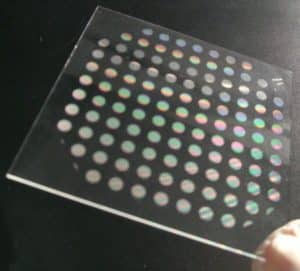Photolithography & Adhesion
A common problem that can occur during photolithography fabrication is adhesion of the photoresist to the substrate. A photoresist consists of a resin, sensitizer, adhesion promoter, and a thinner. Each component contributes to the overall photoresist properties. A resin is included to withstand an etchant solution that may be used in the later stages of fabrication. A sensitizer offers a photosensitive element to the resist that allows it to be exposed in certain areas and not in others. A thinner is included to modify the viscosity of the overall photoresist and make it easier to spin-coat onto the substrate. The included adhesion promoter is often not potent enough to provide enough strength between resist and substrate material.

Photolithography patterning depends on the quality of the adhesion between interfaces. Cleanliness and surface roughness often affect thin-film adhesion. The two most common types of photoresists include positive and negative resists. When a positive photoresist is exposed to UV light, the light strikes areas that are intended to be removed. The UV exposed regions of a substrate are then washed away by a developer solution and un-exposed regions remain insoluble to the developer. For a negative photoresist, UV light exposure causes a photoresist to polymerize or cross-link. The developer solution then removes areas that are unexposed. Positive photoresists are often easier to etch when compared to negative resists due to an increased thermal stability.
A series of baking steps contribute to obtaining adhesion between substrate and photoresist. A soft baking step is included during fabrication to provide complete removal of solvents at the photoresist to substrate interface. This step is crucial to include, as it is used to help prevent photoresist delamination. However, the soft bake temperature greatly influences photoresist film quality. High soft bake temperatures may cause bubbles to form, while low soft bake temps may cause decreased adhesion. A post exposure bake is included towards the end of photolithography patterning. In this step, the sensitizer component of a photoresist solution is stabilized, leading to a more uniform rate of development.
Adjusting baking steps during photolithography fabrication is one way to prevent photoresist delamination. Including additional steps such as a cleaning treatment and incorporating an adhesion promoter can also help mitigate this issue. A UV Ozone or Plasma Cleaning treatment prior to processing can work to clean and dehydrate the surface prior to depositing a photoresist onto a surface. Adhesion promoters offer another alternative solution for enhancing photoresist adhesion. A promoter can be spin coated onto a substrate to increase adhesion.
Platypus technologies offers customizable photolithography patterning services equipped with cleaning treatments, including plasma and ozone cleaning capabilities, to prevent photoresist delamination. Our expertise and knowledge in microfabrication have contributed to a range of projects. Contact us today with your custom project needs at !